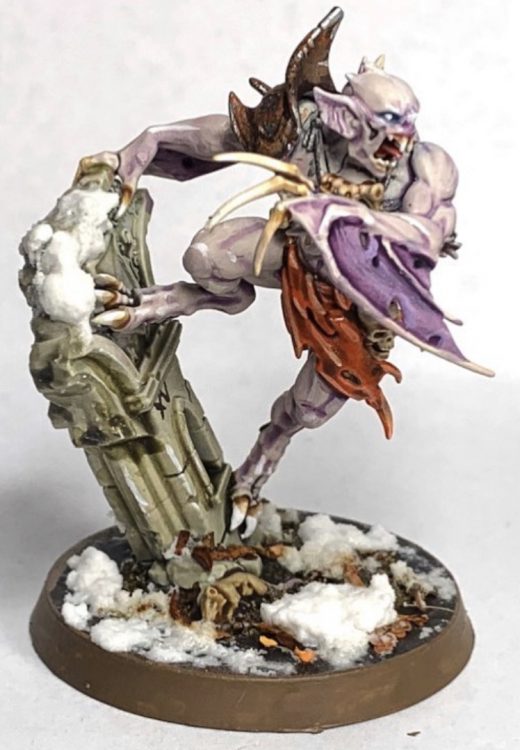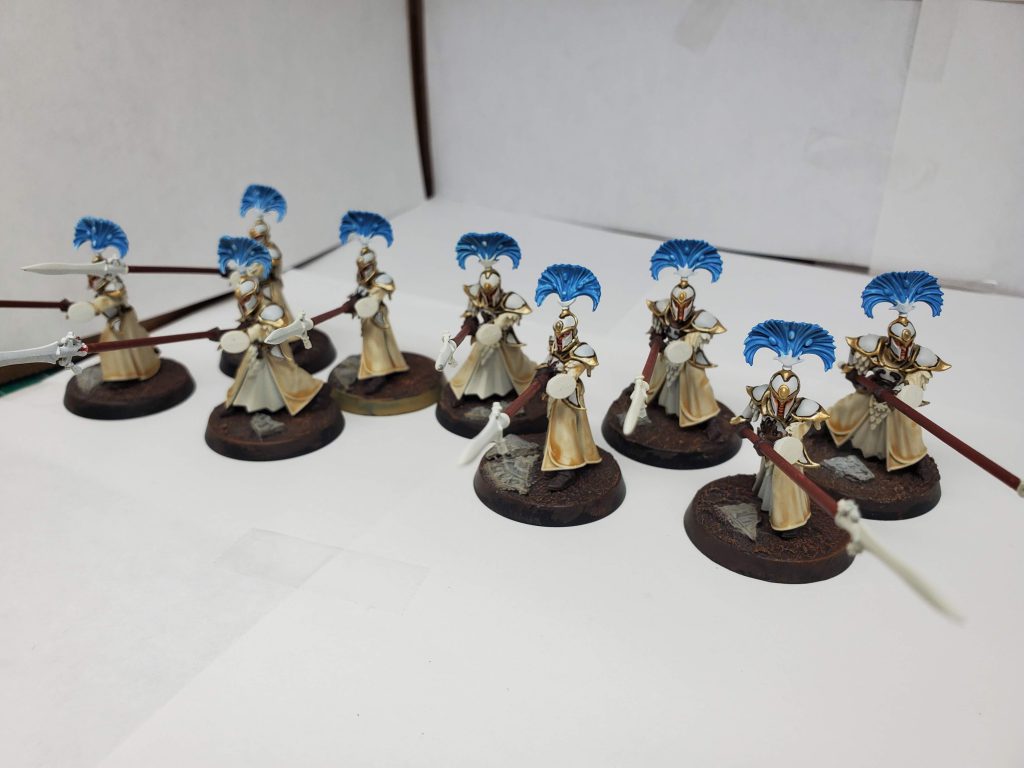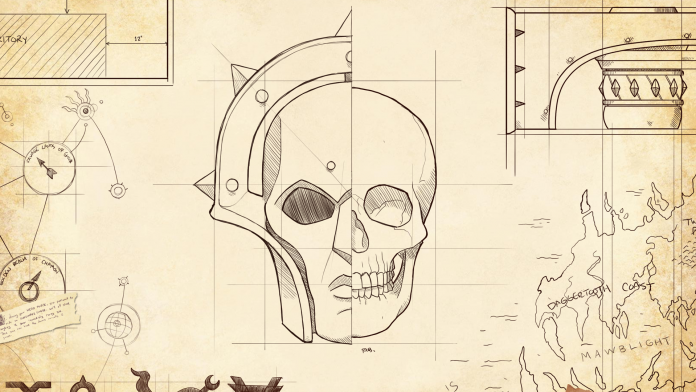A surprise FAQ drop yesterday, largely a hot fix for some…troublesome issues with Flesh-Eater Courts that have cropped up and some more changes to the General’s Handbook. While the number of changed books is small, the impact is quite massive, so we’ll be taking a deeper dive into this.

Battletome: Flesh-eater Courts
Background
In order to explain how this happened we need to contextualize things a bit, because it is unusual that Games Workshop would rush out a patch to fix a single faction. Flesh-eater Courts have been a bit of a misbegotten army in the Age of Sigmar scene. Due to having a pretty egregiously outdated and limited model line, with an outdated tome that really didn’t take the change to 3rd edition well you often didn’t see them at events. If you did it was played by the most hardcore of fans who generally were just ride or die for them
Specifically their biggest problem was that they were an army that absolutely relied on leveraging powerful command abilities to attack multiple times and to bring in new units. Since third edition changed the rules that you couldn’t use the same command ability it drastically curved their power, and the lack of unit variety and failing to keep up with power creep put them to the wayside.
Recently, they’ve gotten a huge spike in notoriety, and the reasons can be pointed to three major factors: First, the new Royal Beastflayers warband, which brought a cheaper Serf unit into the army (We’ll get into why that’s a problem in a minute). Second, Nagash’s new warscroll in the Soulblight and Ossiarch Gravelords, which brought more recursion into an army with a lot of cheap bodies. A minor point can be made about the newer warscrolls in the first book of Dawnbringers as well, but on their own they were fine. The problem occurred that these things, fine on their own, fell onto a perfectly serendipitous sequence of events that allowed them to take advantage of the current game.
Rules Changes
Men-At-Arms and Imperial Guard
First, let’s look at the Beastflayers. The Beastflayers are a new warcry warband, they’re fine. However for just 35 more points they can perform attacks that hit a lot harder than ghouls, and they carry the Serf keyword, which is where the trouble lies. Both the Archregent and Ghoul King have a warscroll ability to summon in a unit for free once per game. Amongst the options, the Arch-Regent could summon 20 Serfs and the King could summon 10. Savvy players asked immediately: Why would you summon Crypt Ghouls when you could get the Beastflayers instead? The primary reason for bringing ghouls, to fulfill a Battleline and a cheaper cost, wouldn’t apply here so there was no reason to choose anything else.
So the change on both Hero’s warscroll now specifically says Crypt Ghouls instead of Serfs. Overall this is probably the most minor of the changes, more that it brings back an actual choice when using the ability.
There’s no end to them!
The biggest change is probably with Death’s specialty and the major reason FEC have become such a hassle: Recursion. The Morgaunt subfaction had a unique command ability Heaving Masses which could be used when a Serfs unit was destroyed. On a 4+, the player could return a unit at full strength on the edge of the board. While powerful this was generally considered fine for most of the book’s life. Crypt Ghouls weren’t very good and they had to be shuffled off to the board edge anyway.
In comes Nagash’s new warscroll. As of his current warscroll, during the Hero phase Nagash can bring back a unit at half strength that had been destroyed on a 3+. There isn’t any requirement that they need to have been destroyed at the time of using the ability however, just that they had been destroyed.
As an example, if a unit of 30 Crypt Ghouls was killed, their player could bring them back at full strength with Heaving Masses and then in the following Hero Phase Nagash could bring back the “Destroyed” unit at a size of 15. That’s right, you could end up with more Crypt Ghouls than you started!
Compounding this, Crypt Ghouls got a bit of a buff, they could now get rend -1 when near a Hero and auto wounded on hit rolls of 6 (5 or 6 if the unit was at least 20 models). At only 80 points this was a steal. And remember what we said about the Beastflayers above counting as Serfs? Do the same thing with 20 Beastflayers. Now FEC had options. They could leverage an absolutely gargantuan number of dice that would chip down the opponent and if killed, come back stronger. This isn’t even counting the buffs they could get through warscroll spells or Hoarfrost, making them virtually unstoppable.
As a result, Heaving Masses was changed to return a unit at only half strength and it specifies that units could only be replaced once, and replacements couldn’t themselves be replaced. This is typical wording on abilities like this now, but was overlooked due to previous books not seeing this as a necessary addendum. This brings it a bit more in line with modern abilities but I think the 4+ is a bit rough – you only get one shot to use it (immediately upon death) and it’s a 50% chance to just whiff. I’d probably have at least dropped it to a 3+ as compensation like Nagash’s ability. But I suppose a new book can’t be too far off.

General’s Handbook 2023-2024
While the General’s Handbook had an FAQ pass already, some things got missed or still don’t quite work right. So let’s look at it again.
First the most clear blunder was probably on the mission Spring the Trap, which states that you may pick up D3 models at the beginning of the game and set them aside to outflank later. The rules, notably, did not specify that they had to be your models. The community generally agreed this was intended but it’s now Rules as Written. An interesting FAQ as well is that Kharadron Overlords may put transports into reserve, but each unit inside would also count toward the limit of D3 units.
Next, the Endless Spell Burning Head was…ill conceived. While the idea is neat, essentially putting a poison debuff on an enemy unit that hurts them each turn, the exact mechanism wasn’t well thought out. Initially, it was said it joined the unit but it was caught upon release that doing so could allow players to manipulate positioning for an advantage, especially in combat. It was then changed to say the burning head became a marker, and was no longer actually on the field. Which then raised the question how you dispel a spell that’s no longer on the field. The new rule just says that the damage only occurs on a 4+ (instead of a 2+) and on a 3 or less the damage stops. Bummer.
Final actual change is to the Magic Made Manifest grand strat, which due to some less than ideal wording seemed to state that there had to be two endless spells on the field or two incarnates, which didn’t make much sense since you can only bring one Incarnate (And only one exists!). It now clarifies that either two endless spells or one endless spell and a friendly Incarnate is sufficient.
The rest are some FAQs, mostly on how Primal Dice work. Some actual interesting ones here. Primal Miscast are not considered the same as miscasts, so if you accidentally roll two ones with a primal die you won’t get out if it just because the enemy is Khorne.
An FAQ shortly after the GHB came out clarified that primal dice are modifiers and therefore cannot be used when one rerolls dice. This gave Slaanesh a bit of an edge, since the Infernal Enrapturess’s Discordant Disruption could force a reroll. FAQ clarifies that rerolls from friendly units and abilities do not allow primal dice, but if the enemy forces it upon you, you can still use them. That’s a relief.
Some rules around the Wizard-finders of Andtor, which confusingly use the Wizard keyword as a qualifier for who can and can’t join (and who they can target) have agreed that any unit that contains a Wizard can’t join and are valid targets of attacks. This is a bit of inconsistent wording on GW’s part, in some cases units of Wizards get the keyword (Like Gobbapalooza) and others don’t (like many Lumineth units). So it was neccesary to clarify when something is a “wizard”.
Conclusion
These changes were…surprising. Not that they weren’t needed, just the sudden timing. Flesh-eater Courts abuse of the Rules as Written was certainly a problem, but it’s interesting that it got such sudden attention. I’d argue it’s not even the worst offender right now, with Soulblight having multiple avenues for non-interactive play (such as filling the board with Zombies, or Legion of Night teleporting in and out for a Blizzard) and Ossiarch Bonereapers just generally being baseline good, it seems weird to just pick FEC out of the crowd to get nailed to the wall.
It likely was easiest to fix, as it mostly boiled down to just a few simple word changes to reset the abilities to their intended use, as opposed to some other armies which may take longer and more comprehensive changes to fix. It’s a start I guess.


